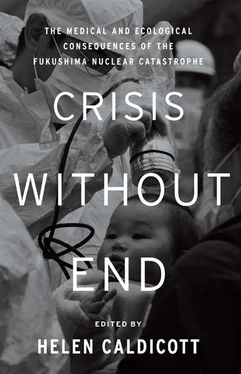The government has not made this easy. TEPCO determines when and what information will be released, such as when the reactor site will be open to the media, when video footage of the accident will be released, and whether the accuracy of government medical reports is in question. Without anyone to ask the right questions, the public is left behind a smoke screen and forced to rely on half-truths. The public’s efforts to end nuclear power in Japan are inspiring, but they are the result of fear, frustration, and uncertainty. Prime Minister Shinzo Abe will ensure Japan remains dependent on nuclear energy. He will restart Japan’s nuclear reactors. Of all the politicians I met, he was the least receptive toward the danger faced by the country’s children and the spent fuel rods at Unit 4. It fills me with sadness that we must sacrifice tens of thousands of children for the public to realize disaster is at hand.
I am surprised that one group has not taken forceful action. The Shinto-Buddhist influence on Japanese life has bestowed a sacred importance on the country’s natural beauty and resources. Japan’s environment has not known a greater threat than that presented by Fukushima. The country’s spiritual leaders should be active in reinforcing the country’s concern about the ongoing risks.
There have been complete core meltdowns in Units 1, 2, and 3. The Japanese authorities have admitted the possibility that some may have made it through the bottom of the reactor core vessels. It has been speculated that this may lead to unintended criticality resumption of the chain reaction or a powerful steam explosion. Either event could lead to major new releases of radioactivity into the environment.
Units 1 and 3 are sites of particularly intense radiation, making those areas unapproachable. As a result, there have been no moves since the accident to reinforce and repair the structures at those sites. The ability of these structures to withstand a strong earthquake is uncertain.
The temporary cooling pipes installed in each of the crippled reactors pass through debris caused by the accident. They are unprotected and highly vulnerable to damage. Any damage to the pipes could lead to the failure of the cooling system and cause the fuel to overheat. Further fuel damage would lead to the release of radiation, in addition to a possible hydrogen gas explosion and zirconium fire, and fuel melting within the spent-fuel pool.
The frame of the Unit 4 reactor building is seriously damaged. The spent-fuel pool in Unit 4, containing a total of 1,670 tons of fuel, is suspended about 30 meters above the ground. TEPCO plans to remove the spent fuel rods in the coming years, but if there is another massive earthquake nearby, this may not be soon enough. If this pool collapses or drains, the resulting radioactive blast will shut down the entire area.
The plant represents an unprecedented international security risk for human civilization. There is a much higher probability of another disaster than one might think. If there is another earthquake and further meltdowns, our future should not depend on chance, the goodwill of TEPCO, or the Japanese government. Meanwhile, the United States stands silent. It is in U.S. interests to take action. Another disaster could cause high quantities of radiation to reach the West Coast through rain or food. Residents would have to be evacuated and relations within East Asia and with the United States would be strained.
A similar disaster could happen in the United States or elsewhere in the world with a nuclear reactor or temporary spent-fuel storage facilities. There are more than four hundred nuclear power plants operating today—more than one hundred of them in the United States. Several sit near fault lines; others are old. There are also twenty-four temporary spent-fuel facilities holding spent fuel rods like those at Unit 4. Many are only warehouses. Cooling systems are so delicate and prone to failure that something as simple as the corrosion of pipelines can set off a meltdown.
In the case of a nuclear accident in Japan or in any other country you can be sure the reaction of the government and the nuclear power industry will mirror that of Japan after Fukushima. They will control all the information and access to the nuclear power plant site, citing national security concerns. The ability to keep information from the public after a disaster must be a privilege, not an expectation. We need to establish what level of access is necessary for science reporters and what level of government discretion is necessary for national security. We need a framework for this agreement. For now this burden lies with investigators. Even outside disaster scenarios, there is no communication between scientists and politicians. This is true here in the United States too. I was shocked to learn how difficult it has been for a top scientist to contact senators and congressmen. This was not the case twenty years ago. A continuous and open line of communication between independent scientists and journalists and politicians is essential for handling a new nuclear disaster effectively.
International action must be taken. There should be a fact-finding mission to Fukushima comprised of select lawmakers from the United States, Russia, the Ukraine, Germany, the United Kingdom, France, and Canada. Senator Ron Wyden set an example by visiting in 2012. UNICEF and the WHO should establish programs to take measures to save the children who are exposed to radiation in the coming decades. Nuclear scientists and medical doctors should collaborate and develop new technology and medicine to treat illnesses associated with radiation exposure.
When Charles, Prince of Wales, spoke at the Rio+20 conference in 2012, he said with regard to climate change: “It is perhaps a trait of human nature to act only when the worst happens. But that is not a trait we can afford to rely on here.” He could have been speaking about Fukushima. Japan is ill equipped to handle the ongoing problem of Fukushima, but this is more than Japan’s problem. It has affected and will affect us all.
7
Effects of Ionizing Radiation on Living Systems
David Brenner
We do not know everything we need to know about the impact of low doses of ionizing radiation on the human body. What we do know is that of the main effects of radiation, including its impact on a developing embryo and fetus, the dominant effect in exposed individuals is cancer.
We know about the cancer risks associated with low doses of radiation through studies of the survivors of the atomic bombs that were dropped on Hiroshima and Nagasaki because both events involved large numbers of people and the follow-up, which included more than a hundred thousand individuals, has lasted for a very long time. To understand the carcinogenic effects of low doses of radiation, the follow-up to any study must cover many decades. A single decade is generally insufficient to gain an overall picture.
In Hiroshima, those at the epicenter perished from exposure to extremely high doses of radiation. Between two thousand and three thousand yards away from the epicenter, people were exposed only to low doses of 5 to 100 millisieverts. This is still higher than the radiation doses at Fukushima. From 1958 to 1998, the total number of solid cancers observed within this group was 4,400. Compare this to the approximately 4,300 expected from a population that was not exposed to additional radiation. The difference is only one hundred, which is a statistically significant increase in cancer risk due to radiation exposure. On the other hand, this is not a large number. In short, low doses of radiation can cause cancer but the individual risks are small.
The reason why an epidemiological study at even lower doses is extremely difficult is that a little more than 40 percent of any population will naturally get cancer, and as you lower the dose of radiation, you have to look for very small increases in risk over and above that 40 percent background. You need larger populations to see that tiny increase in risk. The number of people required for the study is usually prohibitive.
Читать дальше












![Helen Rowland - The Widow [To Say Nothing of the Man]](/books/752764/helen-rowland-the-widow-to-say-nothing-of-the-man-thumb.webp)